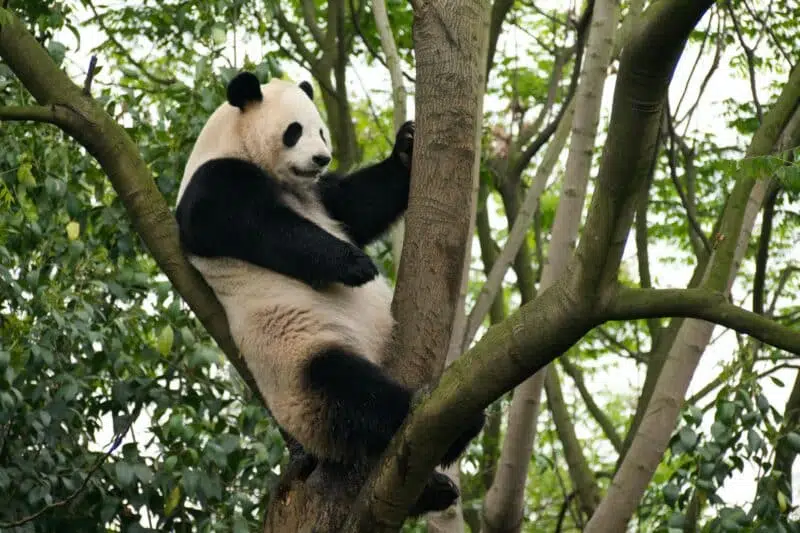Welcome to the Most Endangered Bears around the world.
According to the International Association for Bear Research & Management there are eight species of bears. Here, we will discuss the most endangered bear species and the reasons causing them to be endangered.
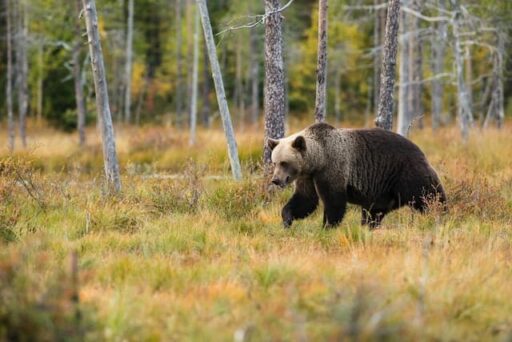
Bears fall into the group of mammals and can be seen in vastly different parts of the world. The ones we see today have evolved from the ancient bears in Africa about 25 million years ago.
Their size may vary from four feet long and about 60 pounds, to a size as big as eight feet long and more than a 1,000 pounds. Bears are the biggest terrestrial creatures and can survive in various climates. Most species are commonly found in North America, Asia, Europe, and South America.
History of Bears:
Bear-history dates all the way back to the Ice Age. They are believed to be among the few animals that survived the extreme cold weather. The evolution over the years is almost considered to be iconic as they go back to doglike ancestors from approximately fifty-five to thirty-eight million years ago.
Also, bears are considered omnivore mammals and often seen as opportunistic feeders. This is because they eat a wide variety of foods, including vegetables, nuts, fruits, and meat.
Moreover, they are introverted animals and will generally only socialize with other bears during the mating season.
Bears & Ecological Systems
Due to their ability to impact their environment, bears are often seen as ecosystem engineers. Also, they spread plants and seeds in their droppings and are hence responsible for supporting the food webs and sustaining the population of animals through predation and providing these three things:
· Fertility of soil
Bears really enjoy eating fish. They enrich the soil by dragging fish remains through the forest. It is beneficial to trees and other types of forest flora. Furthermore, they leave fecal matter on the forest floors.
Animal waste deposits are excellent for soil enrichment. They work as a natural growth enhancer.
· Maintaining a Balance of the Ecosystem
The forest would be covered with carcasses if it weren’t for bears. Bears, although not decomposers, contribute by consuming these carcasses.
Furthermore, because bears are natural hunters, they maintain the ecosystem’s balance by lowering the population of species such as deer, calves, and bucks – to name a few.
· Dispersal of Seeds
Bears aid immensely with seed dispersal. The seeds are not digested when they consume fruits and pass out as waste. Consequently, bears scatter these seeds across the ecosystem, resulting in fresh plant development. Because black bears eat a lot of fruit and plants, they are a particularly important seed distributor.
· Improving Agricultural Yield
The dietary habits of bears can be of crucial importance to humans. They feed on insects in the forest, helping to reduce their numbers. Similarly, they assist in indirectly reducing weed growth. In turn, this indirectly lessens the need for pesticides.
It saves money while also preventing potential health concerns linked with these chemicals.
Habitat
Bears are unique because they are one of the few animals that can thrive in both cold and warm climates. Different species live in vastly different environments, from arctic conditions to the tropics.
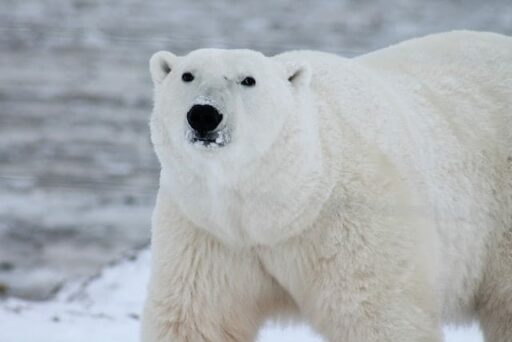
The bears we witness today look very different to those that lived in Asia and Europe around 30 million years ago. They used to be much shorter and stockier than those that are around today. Currently, they appear taller and more slender, with a longer snout and small ears.
We can easily find them on almost every continent except Antarctica. Bears are endangered and classified as a vulnerable species, and killing them is prohibited by authorities. Unfortunately, today the world is left with merely eight species of bears following the course of evolution.
1# North American Black Bear
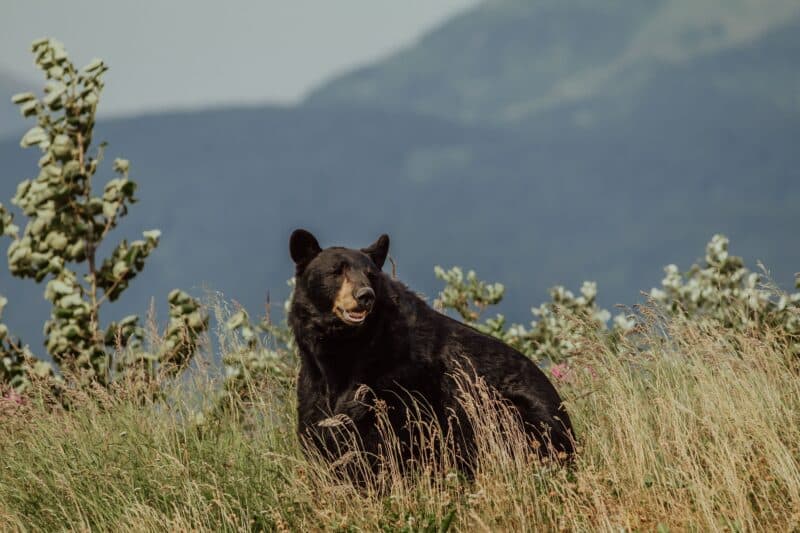
This bear is most commonly found in North America and the state of Florida, Canada, and Alaska. The bear’s black and brown color phases are most common. However, bears with white phases also exist, usually in the areas of northwestern British Columbia and Canada.
The black bear is omnivorous and mostly eats vegetables. Males reach their full size at about eight years, while females reach their full size a year or two later. Females start to reproduce and have cubs when they are 5 to 7 years old. Although in boreal forest zones (Ontario), this tends to happen when they reach 8 years old.
Males may weigh up to 280kg (600 pounds) and, in some cases, much more. In the wild, black bears may live for up to 25 years. Although older bears have been observed, most bears will not survive this long due to hunting activities.
With regards to behavior, black bears are aggressive and protect their territories against other animals, even humans.
2# Brown Bear:
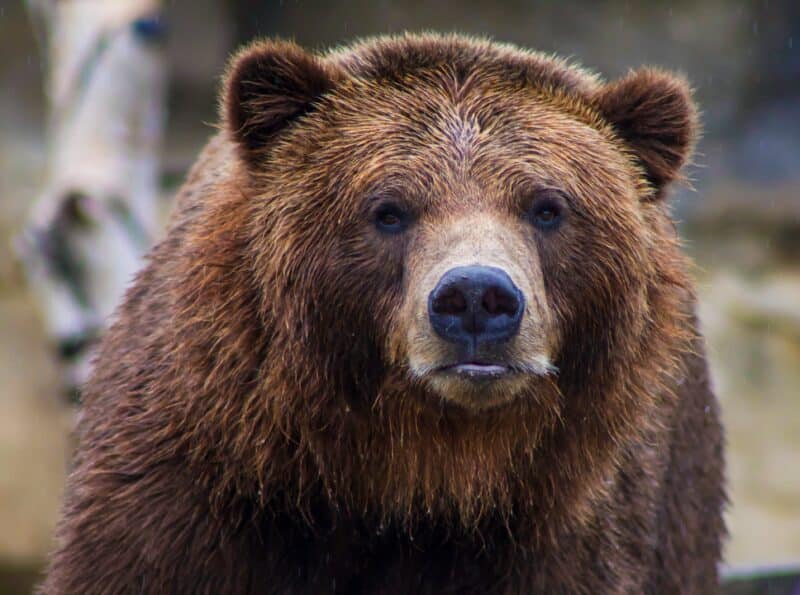
The Brown Bear species is usually found in parts of Washington, Western Canada, Montana, Wyoming, and Alaska. They also exist across Europe and Asia in small populations. Russia especially has a significant population of Brown Bears.
The giant brown bears living along the coast of Alaska and Russia are reportedly very big, resembling Polar Bears. Like the black bears, the brown bears range in color from almost black to brown to very light brown, or even to blonde.
Similarly, their sizes may differ based on geographical region and food availability.
3# Polar Bear:
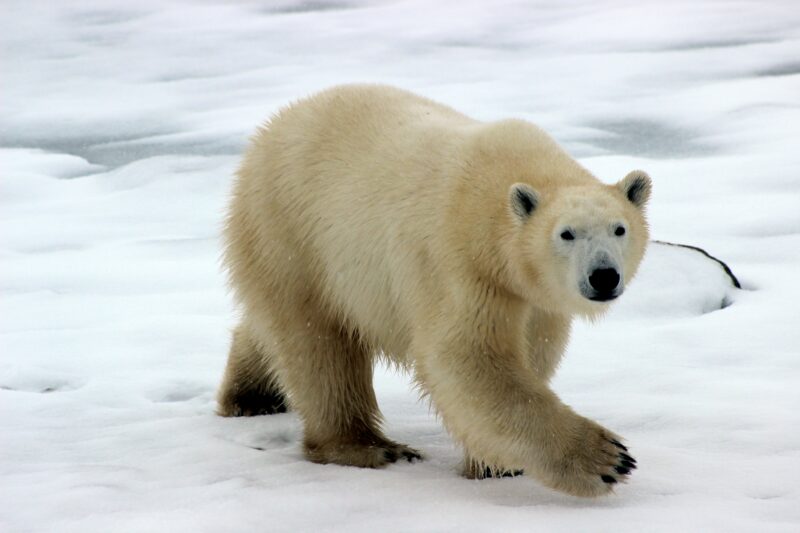
Polar bears are among the world’s biggest bears. In this species, adult males can weigh up to 800 kilograms, or 1,760 pounds. The biggest male bear documented in Ontario from “live catch” research investigations weighed as much as 654 kg (1439 lbs).
On average, male polar bears in Ontario weigh around 500 kg (1100 lbs). Adult female bears are reportedly smaller and weigh roughly 300 kg (660 lbs) on average; their peak weight seldom reaches 400 kg (880 lbs).
The polar bear is usually the first animal that comes to mind when thinking about endangered animals, and rightly so as it is one of the most acutely endangered bears.
4# Asiatic black bear:
This specie type usually has black fur and a characteristic white patch on its chest, which is commonly crescent-shaped. Its fur around the shoulders and the throat is much longer than the rest of the body, and it has distinctively big ears.
Asiatic Black bears are most common in Nepal, Pakistan, Japan, Cambodia, Bangladesh, China, Lao People’s Democratic Republic, Islamic Republic of Iran, Korea, Afghanistan, Myanmar, Russian Federation, Taiwan, and Vietnam.
This type of bear is more carnivorous compared to those in the American region. However, meat contributes to a small part of their diet, including small fish, birds, fishes, and small animal remains.
They usually eat grass, fruits, berries, seeds, insects, and honey. Also, they bulk up in the autumn season for upcoming winters by feeding on different nuts.
Unlike the other panda species, they do not hibernate in the southern climates. Although, the ones found in northern climates often do.
5# Giant Panda/Panda Bear
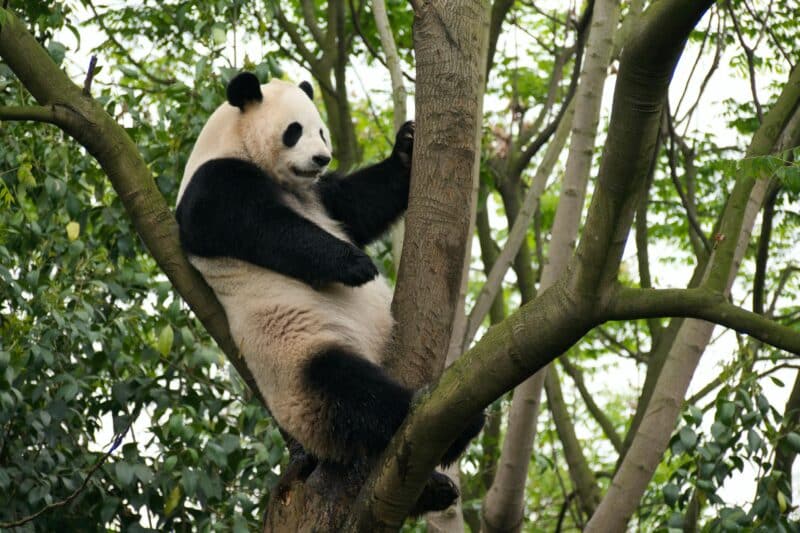
The bears related to this species are very rare and the most endangered. Back in the day, it was strongly believed in science that the giant panda belonged to the raccoon family. Different studies were performed, which later proved it wrong based on DNA analysis.
Giant pandas are famous for being fond of bamboo. The extra digit on the panda’s hand which helps them in tearing the bamboo highlights this. Naturally, a thick layer of mucus covers the gut, and this mucus layer protects the gut from any splinters and disintegration.
The major threat Giant pandas species have been facing is habitat loss. Today, the greatest reason for the decline of giant pandas is due to this. It has resulted in a significant loss of range of where it resides, restricting its territory to six separate mountain ranges in the western part of China.
Let’s have a look at a few of the characteristics discussed below.
· Giant pandas consume a poor diet, therefore requiring 20 Kilograms of food daily.
· At birth, a baby giant panda is hairless and blind, typically 1/900th the size of its mother.
·!– /wp:paragraph –>
6# Sloth Bear
Sloth bears are shaggy-haired bears with long black hair and a white Y or U-shaped marking on the chest. They tend to have long tongues, pale noses and long hook-like claws. The claws are essential as they help them to climb trees and dig for termites.
Sloth bears can suck up termites from a long distance. Male sloth bears have approximately 13 square km average range, which is much less than most other bears. The reason behind this is that their food supply is not as scarce and thus does not undergo major food supply fluctuations.
This food availability also means they do not need to undergo hibernation. Also, Sloth Bears are native to Bangladesh, Nepal, Srilanka, and Bhutan. Moreover, they are nocturnal animals and live in home ranges that they appear to enjoy sharing with other sloth bears.
7# Sun Bear
The Sun Bears is the smallest group amongst the species. They have short water-repellent black/dark brown fur with a bright crescent on their chest. Their significant features include flexible snouts and long tongues (natural adaptation for termites extraction from their nests). They have the longest tongue in the whole bear family.
Its paws are strong and has sickle-shaped claws. Also, the sun bears have the largest canines relative to their size. Moreover, they are the smallest bears. Their canines are useful for tearing meat, although they are not particularly carnivores.
They usually use their sharp teeth as weapons or as instruments to rip through trees to catch insects. Sun bears primarily reside in the southeastern side of Asia in the countries like Brunei Darussalam, Malaysia, Cambodia, China, India, Indonesia, Myanmar, Thailand, and Vietnam.
8# Andean Bear
Scientists usually call spectacled bears “Andean bears” as they only inhabit the Andes mountains in South America. The Andean bear is the last amongst the extant short-faced bear.
Spectacled bears are the surviving species of bear endemic to South America and the sole member of the Tremarctinae subfamily.
Although the Spectacled Bear is theoretically the greatest land carnivore on that continent, meat still accounts for only 5% of its diet. Generally, its fur is blackish, although bears can range from dark black to dark brown, and even with a hint of reddish tone.
The Spectacled bear is a medium-sized bear. Although not all Spectacled bears have “spectacle” markings, one can easily identify them by their characteristic beige-colored patterns over their faces and upper chest.
The pattern and amount of pale markings change significantly between different bears, allowing for easy differentiation between individuals. Males have one-third the proportions of females and can weigh twice as much. They may weigh up to 100-200 kg and 35-82 kg respectively.
The length can range from 120 to 200 cm (47-79 in), with a 7 cm long tail. Compared to other bears, this species has a more rounded face and a comparatively short and wide nose.
Despite the herbivorous dietary preferences of modern spectacled bears, this face structure has been thought to reflect the adaptation to a predominantly carnivorous diet in some ancient species of the Tremarctinae subfamily.
Threats to Bears’ Survival
These are the main threats to our precious bear species existing today.
1. Habitat Loss
The most serious threat to all the bear species is habitat loss. Factors contributing the most to their habitat loss all pertain to human activity, such as: agriculture, deforestation, and the increasing human population. Their hunting range is decreasing by the day due to the destruction of their habitat.
There is a conflict between wildlife, and they are increasingly coming into contact with humans due to habitat loss. Bears are killed as they pose a threat to humans, hunt livestock, or crop raiding.
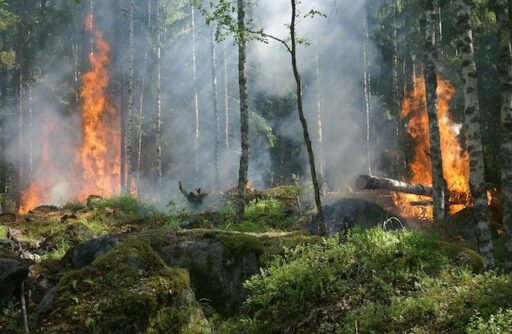
2. Climate Change
Another of the most substantial threats is climate change, especially for polar bears. Polar bears completely depend on ice in order to catch their prey (primarily seals). Often, they have to survive the entire summer without eating anything while waiting for the ice to solidify.
Therefore climate change poses a huge threat as it causes the sea ice to melt at an alarming rate.
3. Natural Threats
There are many natural threats to bears’ survival. Natural threats include diseases, collisions with cars, and predation by other animals, including humans.
4. Human Disturbance
One of the biggest threats to bears is human disturbance. Bears are natural predators, and when humans get in their way, it disrupts their natural prey selection and feeding habits. It can lead to nutritional deficiencies and, ultimately, death.
5. Predation By Other Animals
Bears are vulnerable to predation by other animals. Wolves, panthers, humans and even other bears prey on bears.
6. Disease And Injury
Like all living creatures bears are susceptible to disease and injury. Unfortunately they often become infected with diseases such as rabies, which can be fatal. Besides humans, other animals are also prone to attacking them.
Conservation of Most Endangered Bears
The International Union for Conservation of Nature and Natural Resources considers most bears endangered and vulnerable to extinction. Conservationists are concerned that if specific measures are not taken timely, the situation can exponentially worsen over time.
Only the brown bear and the American black bear are considered species of “least concern.”
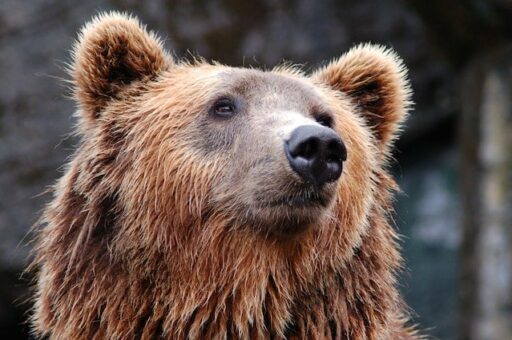
The other six species are threatened due to hunting by people for various reasons and reduction in their habitat. Species such as Asiatic black bears and sun bears are specifically hunted and killed for their gallbladders and different body parts, later sold in the wildlife black markets.
Humans often capture Asiatic black bears for trade purposes or to act in circuses. Other bears, such as spectacled bears and sloth bears, are endangered as they usually conflict with humans over livestock and crops and are attacked in return by humans.
The International Union that works for Conservation of Nature has shared the conservation status of the world’s bears. They label bears as either Endangered (EN), Vulnerable (VU) and Least Concerned (LC).
Extinctinction of Bears
Global warming is driving Earth’s polar bear population to its limit, and a recent study suggests that they may have less than 100 years until they reach extinction. The carnivorous bears hunt seals in the Arctic Ocean, but their habitat is shrinking as more ice melts in that region.
As per reports, the quantity of Arctic sea ice that remains is shrinking at a pace of 13% every decade. Although studies have long demonstrated that the decrease of sea ice would result in polar bear loss, a recent study published in Nature Climate Change forecasts a particular doomsday scenario.
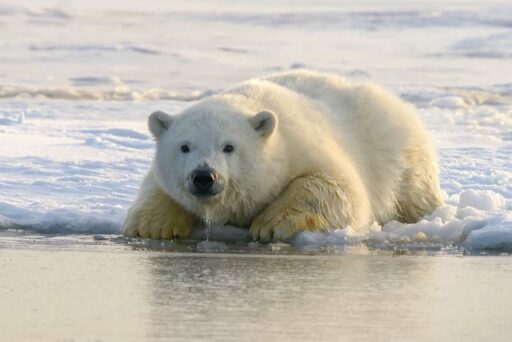
Conclusion on the 8 most endangered bears
In fact, all bear species are endangered albeit to different extents. The most endangered species include Sun bears, panda bears, Polar bears, Asiatic black bears, Spectacled Bears, and Sloth bears.
Bears provide many benefits and are essential for our ecological systems. Sadly, their value is often overlooked.
Many reasons causing their extinction are related to human activity. Therefore it’s important to spread information about these fluffy creatures and to promote conservational measures. Who can resist these fascinating animals which are equal parts cute and vicious?
Thank you for reading this article! If you are still craving more knowledge about the most endangered animals go and check out our article on the Top 10 Endangered Animals in the Amazon Rainforest.
Join our Forum for free today!


